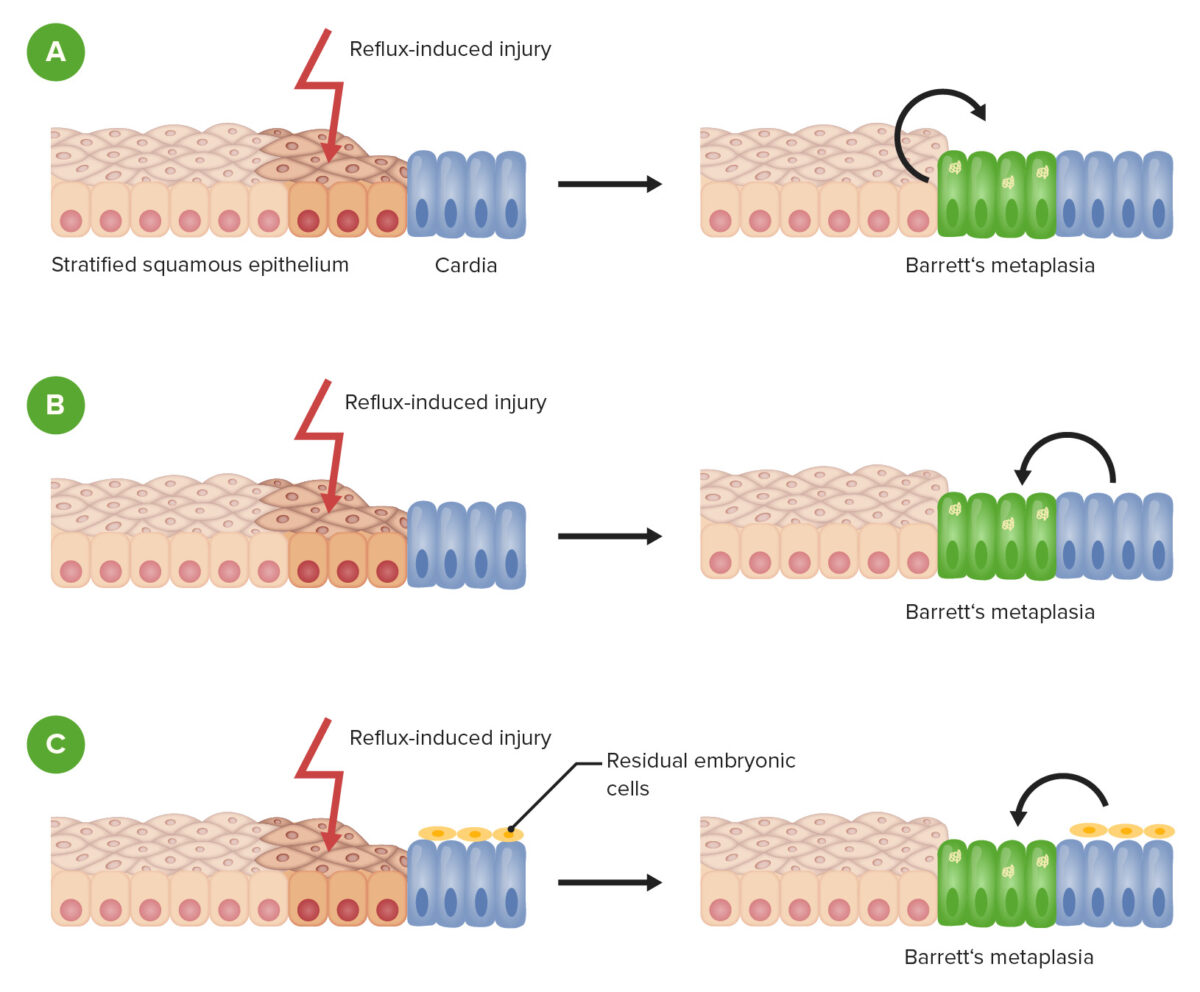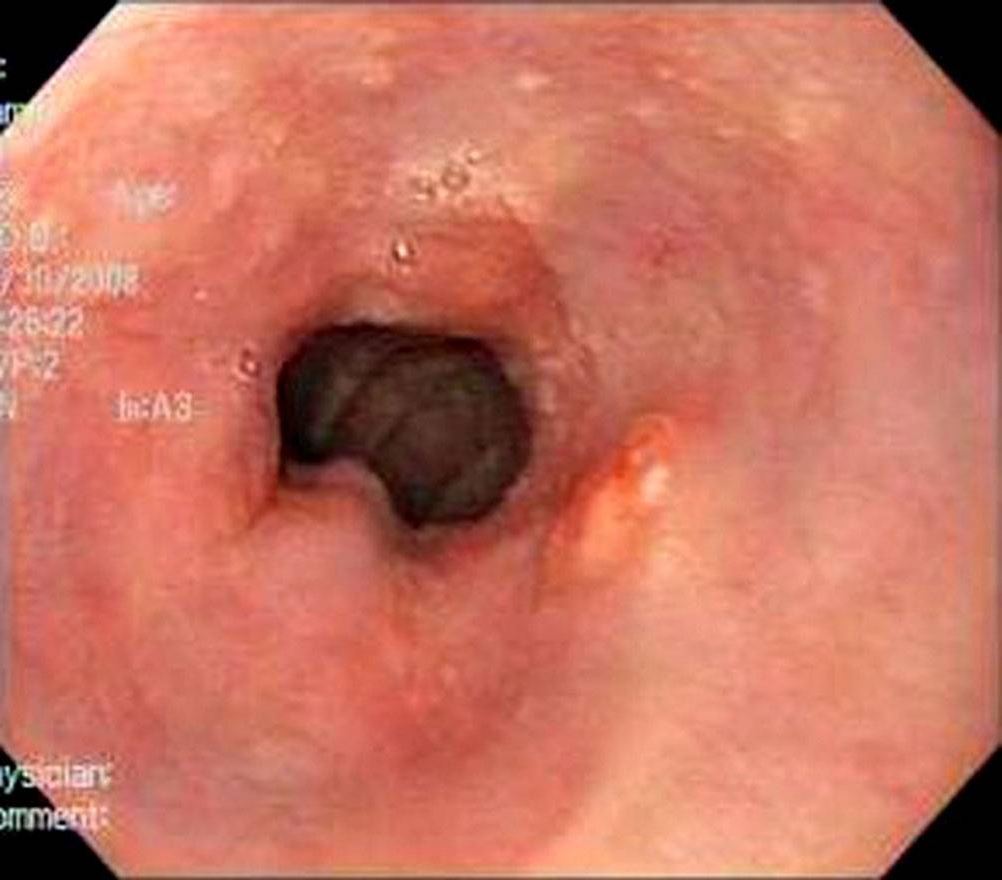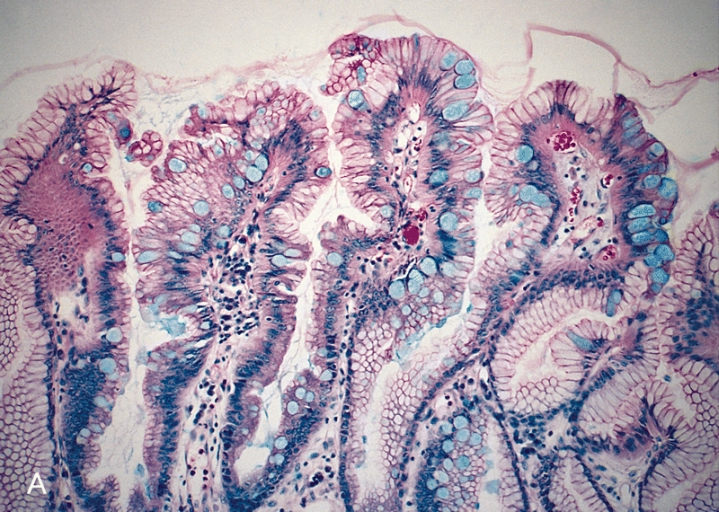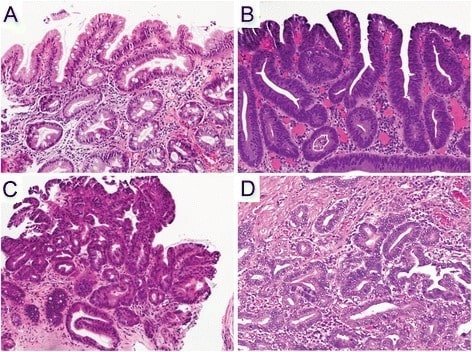Barrett esophagus is a consequence of chronic gastroesophageal reflux disease (GERD) that leads to metaplastic replacement of stratified squamous epithelium with gastric columnar epithelium in the esophagus. The condition is associated with an increased risk of esophageal adenocarcinoma. Workup includes an esophagogastroduodenoscopy (EGD) showing proximal displacement of the squamocolumnar junction (Z-line) from the gastroesophageal junction (GEJ). Diagnosis is made by biopsy revealing columnar epithelium and goblet cells in the distal esophagus. Treatment is primarily with proton pump inhibitors (PPIs) and lifestyle modification. Surveillance with repeat EGD and biopsy is necessary to monitor for early signs of dysplasia.
Last updated: Dec 15, 2025

Barrett esophagus metaplasia.
Schematic demonstrating the development of metaplasia after injury to the esophageal epithelium in Barrett esophagus. There are several proposed mechanisms.
A: Repair of reflux-induced injury leads to transdifferentiation of esophageal epithelial cells.
B: Repair of damaged tissue results from progenitor cells of the gastric cardia.
C: Repair of damaged tissue results from residual embryonic cell migration from the gastroesophageal junction or gastric cardia.
Screening Screening Preoperative Care recommendations:
Procedure of choice is esophagogastroduodenoscopy (EGD):

Esophagogastroduodenoscopy revealing erythematous epithelium in the distal esophagus, consistent with Barrett esophagus. Notice the difference between the erythema of the columnar epithelium and the pale, glossy squamous epithelium. This junction is known as the Z-line.
Image: “Esophageal granular cell tumor colliding with intramucosal adenocarcinoma” by Alkhoury F, Martin JT, Fiedler P, Jaffe PE. License: CC BY 3.0
Esophageal mucosal biopsy showing columnar epithelium and numerous goblet cells (light blue cells in front of the white arrow). This is consistent with Barrett esophagus.
Image: “Barrett mucosa” by The Armed Forces Institute of Pathology (AFIP). License: Public DomainThe management of Barrett esophagus Esophagus The esophagus is a muscular tube-shaped organ of around 25 centimeters in length that connects the pharynx to the stomach. The organ extends from approximately the 6th cervical vertebra to the 11th thoracic vertebra and can be divided grossly into 3 parts: the cervical part, the thoracic part, and the abdominal part. Esophagus: Anatomy has been addressed in several society guidelines, and there is considerable disagreement among experts. The information here is based on:
The goal is to treat underlying acid reflux disease and decrease the risk of cancer development.
Proton pump Pump ACES and RUSH: Resuscitation Ultrasound Protocols inhibitors (PPIs):[2,5,6,11]
Lifestyle modifications:[1,2,5,10]
The intention of close surveillance Surveillance Developmental Milestones and Normal Growth is to detect dysplasia and EAC early and initiate treatment promptly. This will generally be guided by specialist consultation (e.g., gastroenterology).
When Barrett esophagus Esophagus The esophagus is a muscular tube-shaped organ of around 25 centimeters in length that connects the pharynx to the stomach. The organ extends from approximately the 6th cervical vertebra to the 11th thoracic vertebra and can be divided grossly into 3 parts: the cervical part, the thoracic part, and the abdominal part. Esophagus: Anatomy is diagnosed on endoscopy Endoscopy Procedures of applying endoscopes for disease diagnosis and treatment. Endoscopy involves passing an optical instrument through a small incision in the skin i.e., percutaneous; or through a natural orifice and along natural body pathways such as the digestive tract; and/or through an incision in the wall of a tubular structure or organ, i.e. Transluminal, to examine or perform surgery on the interior parts of the body. Gastroesophageal Reflux Disease (GERD):

Hematoxylin and Eosin staining of esophageal mucosal biopsies.
A) Non-dysplastic Barrett’s mucosa characterized by uniform, bland nuclei arranged in a surface monolayer.
B) Low-grade dysplasia exhibiting nuclear hyperchromasia, elongation, and stratification extending up to the surface epithelium.
C) High-grade dysplasia depicting increased architectural and cytologic complexity, including loss of nuclear polarity.
D) Intramucosal adenocarcinoma characterized by severe architectural distortion, including angulated glands. (a-d, 100×)
Diagnosis Codes:
This code is used to diagnose Barrett’s
esophagus
Esophagus
The esophagus is a muscular tube-shaped organ of around 25 centimeters in length that connects the pharynx to the stomach. The organ extends from approximately the 6th cervical vertebra to the 11th thoracic vertebra and can be divided grossly into 3 parts: the cervical part, the thoracic part, and the abdominal part.
Esophagus: Anatomy, a condition in which the normal squamous lining of the
esophagus
Esophagus
The esophagus is a muscular tube-shaped organ of around 25 centimeters in length that connects the pharynx to the stomach. The organ extends from approximately the 6th cervical vertebra to the 11th thoracic vertebra and can be divided grossly into 3 parts: the cervical part, the thoracic part, and the abdominal part.
Esophagus: Anatomy is replaced by intestinal-type
metaplasia
Metaplasia
A condition in which there is a change of one adult cell type to another similar adult cell type.
Cellular Adaptation. It is a complication of chronic
GERD
GERD
Gastroesophageal reflux disease (GERD) occurs when the stomach acid frequently flows back into the esophagus. This backwash (acid reflux) can irritate the lining of the esophagus, causing symptoms such as retrosternal burning pain (heartburn).
Gastroesophageal Reflux Disease (GERD) and a precursor to
esophageal adenocarcinoma
Esophageal Adenocarcinoma
Esophageal Cancer.
| Coding System | Code | Description |
|---|---|---|
| ICD-10-CM | K22.70 | Barrett’s esophagus Esophagus The esophagus is a muscular tube-shaped organ of around 25 centimeters in length that connects the pharynx to the stomach. The organ extends from approximately the 6th cervical vertebra to the 11th thoracic vertebra and can be divided grossly into 3 parts: the cervical part, the thoracic part, and the abdominal part. Esophagus: Anatomy without dysplasia |
| ICD-10-CM | K22.710 | Barrett’s esophagus Esophagus The esophagus is a muscular tube-shaped organ of around 25 centimeters in length that connects the pharynx to the stomach. The organ extends from approximately the 6th cervical vertebra to the 11th thoracic vertebra and can be divided grossly into 3 parts: the cervical part, the thoracic part, and the abdominal part. Esophagus: Anatomy with low grade dysplasia |
Evaluation & Workup:
This code is for an upper
endoscopy
Endoscopy
Procedures of applying endoscopes for disease diagnosis and treatment. Endoscopy involves passing an optical instrument through a small incision in the skin i.e., percutaneous; or through a natural orifice and along natural body pathways such as the digestive tract; and/or through an incision in the wall of a tubular structure or organ, i.e. Transluminal, to examine or perform surgery on the interior parts of the body.
Gastroesophageal Reflux Disease (GERD) (EGD) with
biopsy
Biopsy
Removal and pathologic examination of specimens from the living body.
Ewing Sarcoma, which is the only way to diagnose Barrett’s
esophagus
Esophagus
The esophagus is a muscular tube-shaped organ of around 25 centimeters in length that connects the pharynx to the stomach. The organ extends from approximately the 6th cervical vertebra to the 11th thoracic vertebra and can be divided grossly into 3 parts: the cervical part, the thoracic part, and the abdominal part.
Esophagus: Anatomy. The procedure allows for visualization of the characteristic salmon-colored mucosa and for tissue sampling to assess for dysplasia.
| Coding System | Code | Description |
|---|---|---|
| CPT | 43239 | Upper gastrointestinal endoscopy Endoscopy Procedures of applying endoscopes for disease diagnosis and treatment. Endoscopy involves passing an optical instrument through a small incision in the skin i.e., percutaneous; or through a natural orifice and along natural body pathways such as the digestive tract; and/or through an incision in the wall of a tubular structure or organ, i.e. Transluminal, to examine or perform surgery on the interior parts of the body. Gastroesophageal Reflux Disease (GERD)…; with biopsy Biopsy Removal and pathologic examination of specimens from the living body. Ewing Sarcoma, single or multiple |
Procedures/Interventions:
This code is for
radiofrequency ablation
Radiofrequency ablation
Removal of tissue using heat generated from electrodes delivering an alternating electrical current in the frequency of radio waves.
Hepatocellular Carcinoma (HCC) and Liver Metastases (RFA), an endoscopic procedure used to destroy the metaplastic Barrett’s tissue in
patients
Patients
Individuals participating in the health care system for the purpose of receiving therapeutic, diagnostic, or preventive procedures.
Clinician–Patient Relationship with high-grade dysplasia to reduce the risk of progression to cancer.
| Coding System | Code | Description |
|---|---|---|
| CPT | 43228 | Esophagoscopy, flexible, transoral; with ablation, radiofrequency |